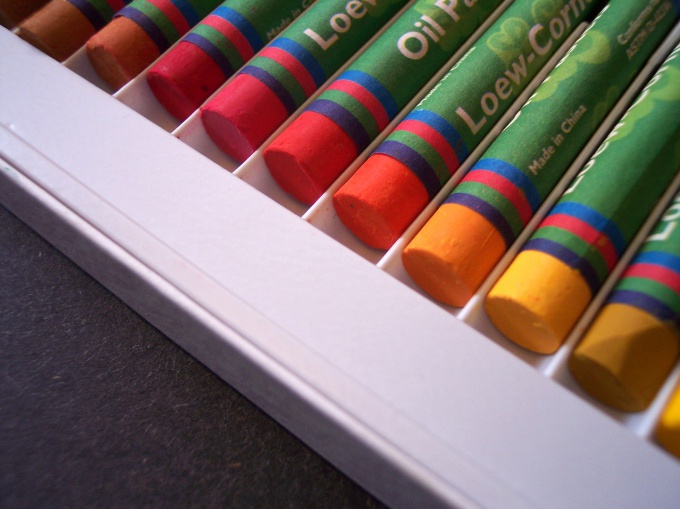You will need
- Wax crayons or pencils, thick and smooth (preferably coated) paper, a knife for sharpening crayons. The technique of "sgraffito" will require either a palette knife or a box cutter or craft knife or stacker for engraving. For the technique of "encaustic" we need a iron with a solid sole. For stained glass painting will need: withstand the heat of candles porcelain plate, a metal tray or sheet for baking; tea lights; a stand for placing a plate or tray over the candle.
Instruction
1
Drawing with wax crayons requires the artist's knowledge of the fundamentals of pencil drawing. In pastels, as you would with a pencil, there is the concept of perspectives and proportions. The shape and texture of objects in a drawing are transferred with the light, the shadows, the gradations of color and direction of strokes. First you need to understand how it behaves wax crayon on paper. Try to paint one color different types of paper (Whatman paper, watercolor, pastels, cardboard or coated). This will give you an idea of how crayons are behaving on different material. Mix several different colors, putting them on the paper and rubbing. So you will understand how to mix various colors and what results you can get when mixing. Wax crayons are sharpened with a knife like a pencil.
2
Drawing with wax crayons starts with a sketch that runs light touches. The sketch can be simple pencil or a crayon dominant color of future paintings. The sketch refers to the contours of the objects that are shown in the figure, and the contours of the white or light areas. The next stage of the picture – the filling in of the outline color. Wax crayons, and oil, are applied to the pattern layers, from dark color to light. If you need to mix two colors: first, to impose a dark, then light color, then blend the colors by rubbing them into the paper with your fingertips. Before you start mixing the colors in the picture, mix them on another piece of paper. So you can't go wrong with a selection of mixed colours. When you smash all the colors in the sketch, according to the intended composition, you need to RUB onto your paper pattern. Crumbs wipe off crayons, and color is gradually added as necessary. Wax crayon should have a smooth, glossy surface through which does not show through the paper texture. In the end, the work is brought to perfection by applying highlights and shadows, drawing thinner lines and small details. Finishing the job is necessary to remember that too by clicking on chalk, which draw on the background erased, you can move the wax already on the drawing. Apply the final touches lightly and carefully.
3
There is also a method of creating a wax pastels, which is called "sgraffito". It means "scratching". For this method you need to do is some paper and wax crayons, or spatula, or stationery (craft) knife, or a special stack. On paper thick superimposed layers of wax crayon. First light pastels, then dark. Next stack (or other tools) on the surface of the scratched drawing. This pattern will resemble an engraving. Method of prozharivaniya you can create a two colored, multi-color work.
4
The following method of painting with wax crayons are fun and easy to implement. It's called "stained glass enamel". To learn, you need to install on the mesh stand, under which are placed a lighted tea lights, a metal or porcelain surface that can withstand heat with tea lights. Suitable even intended for baking the dough sheet metal or ceramic flat shape. On a warm surface is laid a sheet of newspaper and then paper for drawing. Then begins the magic of painting with wax crayons, which melt on the warm surface. Such work would be bright and rich enamels.
5
Following the technique of drawing with wax crayons is called "encaustic". You need to take iron with a solid sole (ie no holes for steam) and place the heat on low. You will also need crayons and thick cardboard with a smooth surface. Iron, which is slightly heated, turn it sole up and at it draw the figure with wax crayons. Then suddenly turn it upside down and drive them through the cardboard. We get fantastic abstract wax stains, which you can then bring to perfection drawing the more subtle and fine details. The wizard can't just churn out abstract paintings, but also to create masterpieces by drawing the details of the edge of the soleplate.
6
Another way is to blur the wax with turpentine or white spirit. Light touches of wax crayons the drawing and then the wax is washed out by turpentine and a brush. Art brushes made of synthetics will be here could not be more helpful. You will get a surprisingly light and transparent as watercolor, drawing.
Note
Choosing crayons in the store, try to choose those that are made from natural types of wax. Cheap paraffin wax crayons are less plastic, worse mixed and rubbed into the basis of the drawing. No need to choose to mix too many colors at the same time. This can give unpredictable results, which will spoil your figure.
Useful advice
It is better to RUB the crayons on the paper with your hands, paper retouchers are not very good for this. However, you can apply retouchers, slightly soaked in turpentine or white spirit to soften color transitions and blending of colors on paper. Among other things, break crayons in half to have both sharpened and blunted crayons of the same color. Not large crayons with a variety of edges and chips - it is more convenient to draw.
